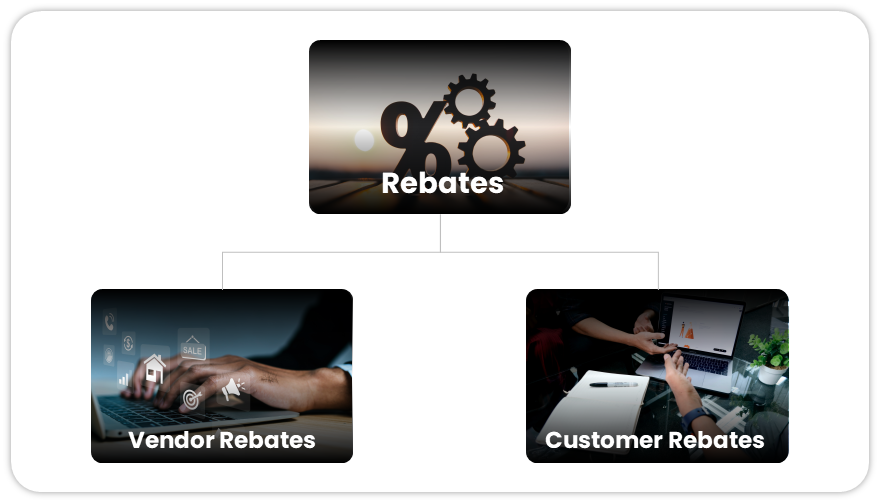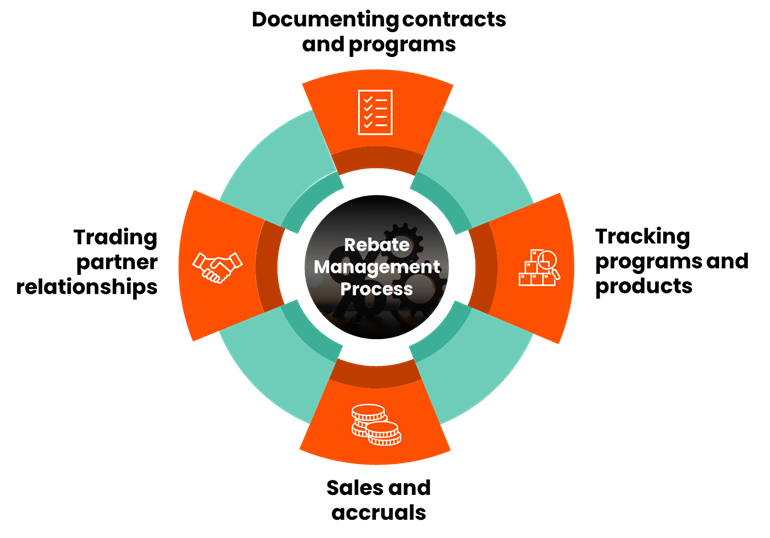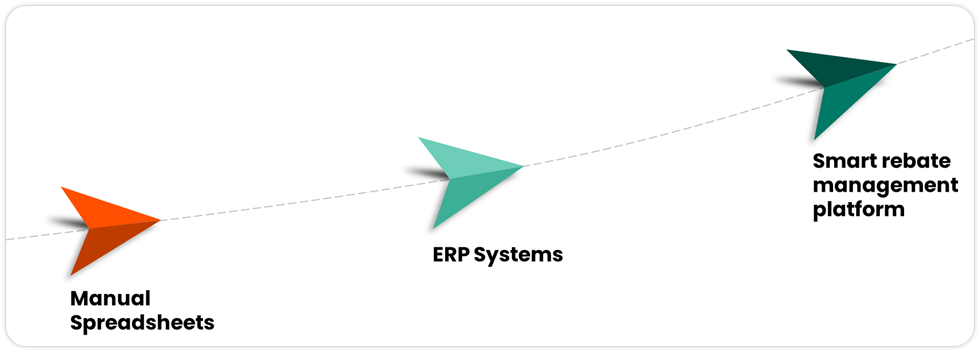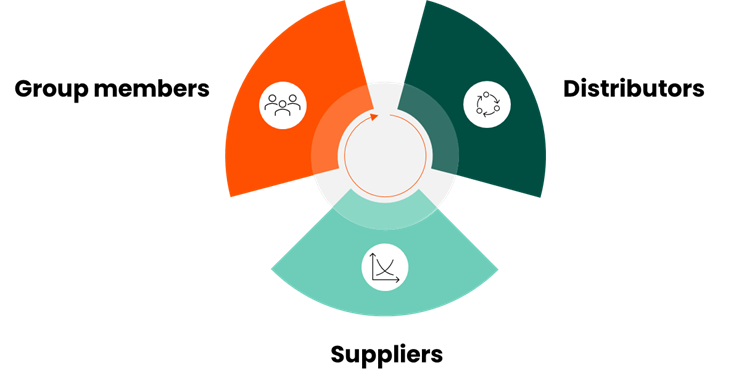What is a rebate program?
A rebate program is built on this simple logic – A buyer agrees to purchase a specified volume or amount of product for an agreed-upon price from a seller. After the purchase, the seller refunds a predetermined percentage of the price paid by the buyer.
Here, the seller incentivizes the sale of his goods rather than slashing their prices. This enables the seller to push a greater volume of goods into the market. On the other hand, the buyer reaps low costs and increased profit margins—a win-win for both parties.
Rebates contribute significantly to B2B transactions in many industries and market segments, including electrical, construction materials, automotive parts, pharmaceuticals, and cosmetics.
Why are rebates necessary?
To understand the significance of rebates, let us consider an example. Imagine you are a manufacturer. You offer an attractive discount to buyers, in an attempt to boost sales. A buyer promises to buy 5,000 units of a particular product from you. But he is unable to fulfill his promise and purchases only 3,000 products. He earns the applicable discount and makes a decent profit. On the contrary, you end up facing a financial loss as your discount has eaten up your profits.
This is where rebates are helpful. In a rebate, the buyer captures the discount only when he fulfills the incentive requirements. So, in the above example a rebate deal could be set up in advance. The buyer receives a specific discount if he purchases 2,000 products, a higher discount for 3,000 products, and a much higher rebate if he buys 5,000 products from you.
Buyers also benefit from understanding the rebate program in advance of the purchase transaction. They can compare deals from different manufacturers through fixed rebate schemes, understand price deviations and profit margins, and then choose the best deals. This integrated approach benefits both the seller and the buyer.
Rebate types:
When classified broadly, rebates are of two types: Vendor rebates and Customer rebates. Vendor rebates focus more on distributors and buying groups, while customer rebates involve manufacturers and merchants. A vendor rebate program involves accounts receivables, while a customer rebate deals mainly with accounts.

Is it tough to manage rebates?
Rebates are easy to manage when the transactions are fewer, between limited parties, and with minimal products. But gradually, with the increasing number of deals, their varying terms, and a more considerable number of programs and products, managing rebates tends to get complex. In addition, evolving rebate programs involve an increasing number of suppliers, buying groups, and manufacturers. Such scenarios bring new challenges in handling partner relationships, managing data, monitoring rebate performance, and stakeholder management.
Hence, the need arises for a robust management process to streamline the operations in the rebate ecosystem.
Did you know? Over $500 million in rebates go unfulfilled every year. If you don’t want your dollars to add to this number, Talk to us right away
What is rebate management?
Rebate management is the process of documenting and tracking rebate contracts, sales and accruals on time and managing trading partners .

The evolution of the rebate management system
Over time, the rebate landscape migrated to the Enterprise Resource Planning (ERP) system. An ERP system
- Reduces the necessity for manual data feed-in
- Standardizes critical processes
- Supports large-sized businesses
- Provides access to reliable data and
- Improves data security
However, ERP systems were not without challenges. On using the ERP system, people realized the system was
- Expensive to implement and maintain
- Time-consuming to drive promised benefits and
- Dependent on experts to handle and maintain the system
Also, ERPs did not wholly eliminate manual data input processes, and hence, probability of human errors persisted.
Evolving expectations of the stakeholders and the ecosystem
As the rebate landscape grew exponentially, stakeholder requirements also evolved drastically. They started expecting forecasts and predictive analytics to identify buying trends, ROI, and performance tracking so that they could plan their purchases and negotiate deals accordingly.
Stakeholders also wanted a real-time single view of rebate data to monitor rebate performance without depending on other resources for inputs on rebate earnings and accruals. ERP systems could not support these advanced capabilities, and thus, a smart rebate management solution became a “Must Have” as opposed to a “Nice to Have”.

Comparison of the traditional ERP system with the modern rebate management system
The advent of an intelligent rebate management platform has proven to be a game changer. It is much more efficient than the ERP system and offers advanced analytical capabilities to improve rebate ROI. Some of the salient features that make an AI-driven rebate management platform a great choice when compared to the traditional ERP system are:
Table
An all-encompassing rebate management platform to make rebates seamless
Introducing Tredence’s Rebate.ai– your one-stop solution for all your rebate requirements. Below are a few distinct capabilities of our AI-powered, data-intelligent rebate management platform that can serve as your able partner in making rebates seamless and achieving enhanced rebate ROI without hassle.
Creating E-bates: Electronic rebate programs automate rebate proceedings and offer real-time data view and access to all stakeholders. It helps in monitoring each of the hundreds of vendors and buying groups, along with their thousands of rebate programs, with precision. This allows an agile rebate tracking platform for everyone involved in the rebate ecosystem. The platform offers data transparency, allowing distributors to negotiate terms with data-backed claims and strike mutually beneficial deals without friction.
Offering data security: Our trustworthy platform saves your rebate data on the cloud. This ensures your data is encrypted and secured through strong credentials to minimize cyberattacks and security breaches. Cloud adoption is also economical, as you only pay on-the-go for the storage space you utilize. The cloud facilitates secure access to real-time data anywhere and anytime, ensuring seamless collaboration between stakeholders.
McKinsey says 8 out of 10 B2B decision makers will switch suppliers if performance guarantees are not met. If you don’t want to be 1 among them, It is time to act!
Managing trading partner relationships: Imagine you are a buying group member. Your group handles hundreds of rebate programs, each corresponding with 150 different suppliers. Will you be able to track and manage them all manually and efficiently? The answer is no.
Our smart rebate management platform can do that for you. It manages the rebate programs and extracts contextual insights based on historical data and rebate performance. With such real-time data inputs, you can indulge in a collaborative decision-making process with fellow stakeholders such that everyone’s investments get rewarded with maximized ROI on puchases. Similarly, it benefits other stakeholders, too, in an unbiased and transparent manner.
Providing data quality management: Our AI-powered rebate management system leverages data to offer business and revenue benefits. Functionalities like data cleansing, validation, and enrichment curate the massive volume of rebate data. It equips all users with clean, trustworthy data that empowers them with actionable insights to boost their decision-making intelligence.
Providing equal growth opportunities for all stakeholders: One of the unique capabilities of our AI-powered rebate management platform is that it is an equal opportunity provider for all stakeholders.
Are you a distributor? For your convenience, our interactive dashboard maps all purchases you made to each suppliers growth rebate programs to track achievement of each tier threshold by clearly identifying the ROI on your future purchases. This helps you identify relevant opportunities and converse with potential suppliers to strike rewarding deals.
If you are a supplier, your customized dashboard provides you with a hunting list comprising the top 10 distributors who purchase competitive products available in their product category. You can utilize these conversion opportunities and negotiate with those distributors to arrive at fair deals.
On the other hand, if you are a buying group member, our platform empowers you with advanced features like auto-rebate governance, group health tracking, auto-group compliance, a unified product catalog, and external trade insights.

Our platform is truly user-friendly, customizable, and efficient. It is a data-driven, trustworthy system that makes rebate management seamless.
Spearhead the revolution in rebate management. Partner with us.
What’s the average ROI to expect from rebate analytics?
Now to the obvious and perhaps most pressing question – what is the average ROI you can expect on using our platform?
Any business’s ROI is dependent on numerous factors, and they are highly business and industry specific. With our intelligent rebate management system, our clients have experienced an average increase of 2 percentage points in their rebate earnings. What would a 2 percentage point increase mean to your business?
If the average rebate earnings are 8% of purchases, our platform has helped businesses scale that average to 10%.
Translating this to numbers, imagine a distributor has earned rebate earnings of $20 million at 8% of purchases. Using our platform, at the new 10% slab, his rebate earnings increase to $25 million.
That’s a massive $5 million additional income via effective rebate management leveraging an intelligent rebate management platform!
Now that you understand the potential for increased RoI, talk to us to understand how we can help you scale and improve your rebate program efficacy.
When to expect results on using our platform?
Once you have adopted the platform, our solution begins to deliver returns within two months of implementation.
Schedule a walk-through with our experts to understand our platform better. It will help us clear the air about our platform’s capabilities and set the right expectations.
How to get started with our platform
On partnering with us, your journey to success has already begun. Based on your expectations and requirements, our team formulates a customized framework to guide you throughout your rebate path of rewards. To summarize our services:
- We begin with migrating your existing data to our platform.
- This involves cloud migration, resource mapping, and data curation to remove redundancy.
- We eliminate siloed processes and systems and other traditional and manual practices that have turned obsolete in the long run.
- We deploy our platform and take complete ownership of its end-to-end support and maintenance.
- We ensure the platform is tailor-made to meet your specific demands, whether you are a distributor, supplier, or buying group member.
- We ensure our resources help you grasp the newly implemented platform and guide you until you realize results.
Schedule a personalized demo for a customized solution.
Making our partners’ rebate processes future-ready
The future is tech-driven, and we are armoring our clients to win the battles.
To make you understand how we are doing this – there is no better testimony than a satisfied customer. Look at what a few of our happy clients have to say about using our platform:
<strong”>John Aykroyd, President of IMARK Plumbing, mentions, “Rebate.ai offers a dashboard that provides numerous data points that benefit members and suppliers. Members can access in-depth analytical tools that offer guidance to maximize member’s rebate
The rebate creation process is extremely smooth and easy to use.
– Yelena Veksler, Network Distribution
Jerry Knight, President, of IMARK Electrical, says, “Tredence’s rebate.ai delivered IMARK electricals’ members and preferred suppliers a competitive edge by providing information to identify product and supplier conversion opportunities in a secure and easy-to-use platform. It is the only authorized rebate management


